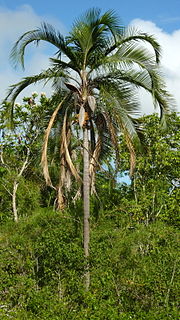
Syagrus is a genus of Arecaceae (palms), native to South America, with one species endemic to the Lesser Antilles. The genus is closely related to the Cocos, or coconut genus, and many Syagrus species produce edible seeds similar to the coconut.

Syagrus coronata, commonly known as the ouricury palm, aricuri palm, or licuri palm, is a species of palm tree that plays an important role in the diets of tropical seasonally dry forest animals. It is native to eastern Brazil, ranging from the southern part of the state of Pernambuco, into the state of Bahia, south to the Jequitinhonha River in the state of Minas Gerais. It can live for 30-150 years, however most only live for 8-10 years on average.

The dusky-legged guan is a species of bird in the family Cracidae, the chachalacas, guans, and curassows. It is found in Uruguay, northeastern Argentina and southernmost areas of Paraguay and Brazil. In early 2021, the former subspecies P. o. bridgesi, found in southwestern Bolivia and northwestern Argentina, was elevated to species rank as Yungas guan.

Syagrus botryophora is a species of flowering plant in the family Arecaceae. It is found only in Brazil. It is threatened by habitat loss.

Syagrus glaucescens is a species of flowering plant in the family Arecaceae. It is endemic to Minas Gerais state in southeastern Brazil. Its small population is threatened by collecting and habitat destruction.
Syagrus macrocarpa is a rare species of palm found only as scattered isolated individuals and small groups in the east of the Brazilian states of Espírito Santo, Minas Gerais and Rio de Janeiro. It grows to 4-10m tall, with 8-20 leaves to 2m long. The leaves are bent at the end, with very hairy margins near the trunk, and consist of 180-320 slightly coiled leaflets irregularly arranged in several planes on the rake. The fruit are oval, greenish-yellow, 6–9 cm long. It is grown in cultivation. Seeds are difficult to germinate, with low rates of germination. Common names for it in Minas Gerais are baba-de-boi-grande and maria-rosa.
Syagrus picrophylla is a species of flowering plant in the family Arecaceae. It is found only in Brazil.

Syagrus pseudococos is a species of flowering plant in the family Arecaceae. It is found in tropical rainforest and on rocky outcrops in eastern Brazil along a coastal strip from extreme south of state of Bahia south through Espírito Santo, Rio de Janeiro to São Paulo.
Syagrus ruschiana is a species of flowering plant in the family Arecaceae. It is found only in Brazil.
Syagrus smithii is a species of palm tree found in Brazil, Colombia, Ecuador and Peru.
Bleasdalea papuana is a species of plant in the family Proteaceae. It is found in West Papua in Indonesia and Papua New Guinea. It is threatened by habitat loss.

Helicia is a genus of 110 species of trees and shrubs, constituting part of the plant family Proteaceae. They grow naturally in rainforests throughout tropical South and Southeast Asia, including India, Sri Lanka, Indochina, Peninsular Malaysia to New Guinea and as far south as New South Wales.
Helicia albiflora is a species of plant in the family Proteaceae. It is endemic to Papua New Guinea. It is threatened by habitat loss.
Helicia amplifolia is a species of plant in the family Proteaceae. It is endemic to Papua New Guinea. It is threatened by habitat loss.
Helicia calocoma is a species of plant in the family Proteaceae. It is endemic to Papua New Guinea. It is threatened by habitat loss.
Helicia insularis is a species of plant in the family Proteaceae. It is endemic to Papua New Guinea. It is threatened by habitat loss.
Helicia latifolia is a species of plant in the family Proteaceae. It is endemic to Papua New Guinea. It is threatened by habitat loss.
Helicia neglecta is a species of plant in the family Proteaceae. It is endemic to Papua New Guinea. It is threatened by habitat loss.
Helicia peltata is a species of plant in the family Proteaceae. It is endemic to Papua New Guinea. It is threatened by habitat loss.
Helicia subcordata is a species of plant in the family Proteaceae. It is endemic to Papua New Guinea. It is threatened by habitat loss.







